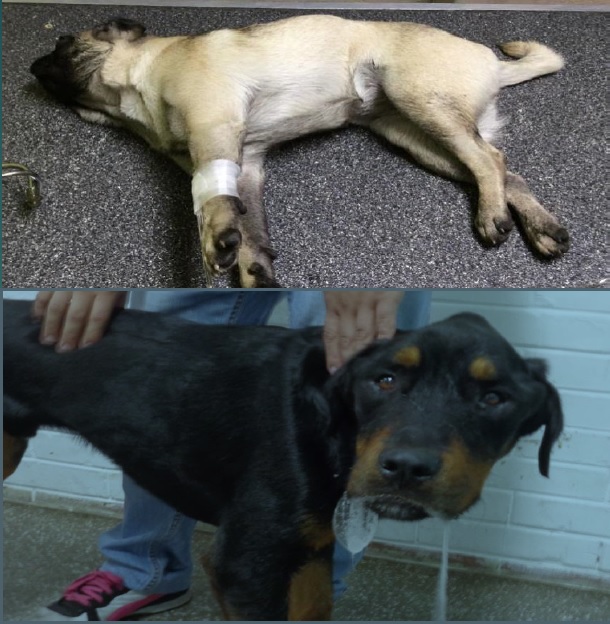Characterization of neurological diseases in canines: University of San Carlos of Guatemala, year 2017
Caracterización de enfermedades neurológicas en caninos: Universidad de San Carlos de Guatemala, año 2017

Show authors biography
Objective. Determine the case frequency of neurological diseases, as well as age, race, and the affected neuroanatomical site. Materials and methods. A retrospective study of the clinical records of the canine patients treated at the veterinary hospital of the Veterinary Medicine and Animal Husbandry Faculty of the University of San Carlos of Guatemala on year 2017. The data were classified according to the VITAMIN D mnemonic rule. The variables sex, race, age and neuroanatomic location of lesions were included. The data were summarized and analyzed using descriptive statistics through frequency distribution tables. Results. Of the 1127 case records, the prevalence of neurological diseases was 8.43%. The frequency was higher in males that in females (53.68% vs 46.32%). The age group most affected is between zero and seven years old. Regarding breeds, a higher frequency was observed in dogs without a defined breed (25.53%) followed by French Poodle dogs (20.21%). The pathologies frequencies found were: vascular (1.05%), inflammatory / infectious (25.26%), traumatic (13.68%), metabolic (8.42%), idiopathic (6.32%), neoplastic (1.05%) and degenerative (44.21%). The most frequent neurolocation was at the level of the SNC (86.32%). Conclusions. According to the findings of this study, it was determined that degenerative diseases represented most of the neurological case frequency. The highest frequency of cases occurred in young canine patients, males of mixed breeds. The most frequent neuroanatomic site of lesions was in the spinal cord at the thoracolumbar level.
Article visits 1449 | PDF visits
Downloads
- Taylor S. Trastornos neuromusculares. En: Couto CG, Nelson RW. Medicina Interna de pequeños animales. 4ta ed. Barcelona España: Editorial Elsevier; 2010.
- Pellegrino F, Pacheco E, Vazzoler M. Caracterización de los trastornos neurológicos en los perros: 1652 casos (marzo 2008-junio 2010). Parte 1. Rev Neurol Arg. 2011; 2(1):78-96. https://neurovetargentina.com.ar/revista/revista_neurologia_02.pdf
- Pellegrino F. Las claves del diagnóstico neurológico para el veterinario clínico. 1ª ed. Buenos Aires Argentina: Inter Médica; 2014.
- Mondino A, Piaggio J, Loureiro C, Vasconcellos R, Delucchi L. Efecto de la raza, sexo y edad en la presentación de enfermedades del sistema nervioso central en caninos atendidos en el Hospital de la Facultad de Veterinaria de Uruguay. Veterinaria (Montevideo). 2015; 51(199):4-11. http://www.revistasmvu.com.uy/index.php/smvu/article/view/119/64
- Fluehmann G, Doherr M, Jaggy A. Canine Neurological diseases in a referral hospital population between 1989 and 2000 in Switzerland. J Small Anim Pract. 2006; 47(10):582-587. https://doi.org/10.1111/j.1748-5827.2006.00106.x
- Chaves RO, Beckmann DV, Santos RPD, Aiello G, Andrades AO, Baumhardt R, et al. Doença neurológicas em cães atendidos no Hospital Veterinário da Universidade Federal de Santa Maria, RS: 1.184 casos (2006-2013). Pesq Vet Bras. 2014;34(10):996-1001. https://doi.org/10.1590/S0100-736X2014001000012
- Murakami T, Feeney D, Willey J, Carlin B. Evaluation of the accuracy of neurologic data, survey radiographic results, or both for localization of the site of thoracolumbar intervertebral disk herniation in dogs. Am J Vet Med Res. 2014; 75(3):251-259. https://doi.org/10.2460/ajvr.75.3.251
- Shimose CP, Salinas CE. Caracterización de lesiones en columna vertebral mediante tomografía computarizada en canes de Lima, Perú. Rev Investig Vet Perú. 2018; 29(1):132-141. http://dx.doi.org/10.15381/rivep.v29i1.14204
- Pérez M, Verde MT, Unzueta A. Lesiones radiográficas y participación de factores individuales en la espondilosis deformante y la esclerosis vertebral en perros. Rev AVEPA. 2003; 23(1):18-24. https://ddd.uab.cat/pub/clivetpeqani/11307064v23n1/11307064v23n1p18.pdf
- Kranenburg H, Voorhout G, Grinwis G, Hazewinkel H, Meji B. Diffuse idiopathic skeletal hyperostosis (DISH) and spondylosis deformans in purebred dogs: a retrospective radiographic study. Vet J. 2011; 190(2):e84-e90. https://doi.org/10.1016/j.tvjl.2011.04.008
- Mendes D, Arias M. Traumatismo da medula espinal em cães e gatos: estudo prospectivo de 57 casos. Pesq Vet Bras. 2012; 32(12):1304-1312. https://dx.doi.org/10.1590/S0100-736X2012001200015
- Arias M, Severo M, Tudury E. Trauma medular em cães e gatos: revisão da fisiopatologia e do tratamento médico. Semina. 2007; 28(1):115. https://doi.org/10.5433/1679-0359.2007v28n1p115
- Itoh H, Hara Y, Yoshimi N, Harada Y, Nezu Y, Yogo T, et al. A Retrospective Study of Intervertebral Disc Herniation in Dogs in Japan: 297 Cases. J Vet Med Sci. 2008; 70(7):701-706. https://doi.org/10.1292/jvms.70.701
- Alvarado-Peréz A, Villatoro-Chacón D, Chávez-López J, Arizandieta-Altán C. Caracterización de la población canina atendida en el centro municipal de atención canina de la ciudad de Guatemala. REDVET. 2017; 18(12):1-9. http://www.veterinaria.org/revistas/redvet























